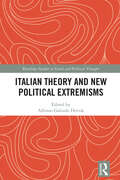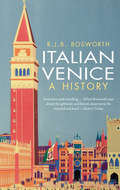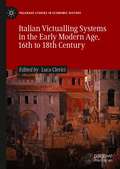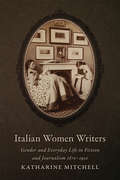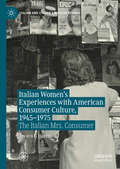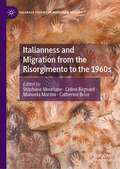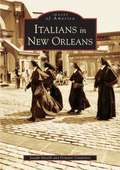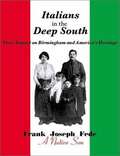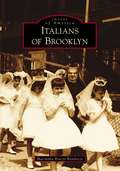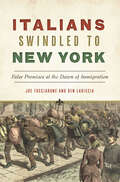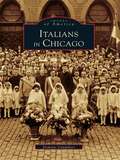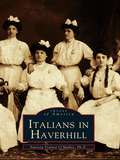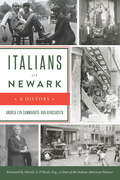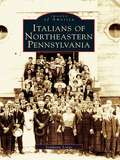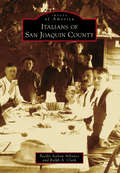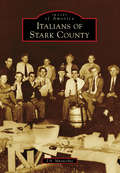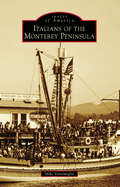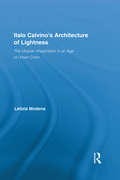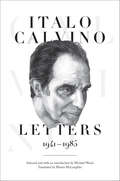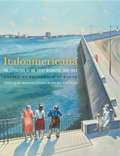- Table View
- List View
Italian Theory and New Political Extremisms (Routledge Studies in Social and Political Thought)
by Alfonso Galindo HervásSo far this century, the most developed democratic societies have witnessed the emergence of various extremist political movements. Some have nationalist connotations, others religious; there are right-wing and left-wing, pacifist and violent, with environmental or social motivations, etc. But they all share reactionary, dogmatic and illiberal traits. Such movements testify to some of the limitations of our societies and the condition of life in them. Therefore, understanding the challenges they pose to our institutions is vital not only to confront them but also to identify their shortcomings and work to improve them.Using Italian Theory as a conceptual lens, this book provides genealogies of current extremist political movements, their theoretical assumptions and the challenges they imply. Succinct and accessible chapters discuss different manifestations of political extremism: its violence, its relation to populism, its religious dimension, its conception of political action, some of its intellectual influences and its anti-liberal and totalitarian character, to name a few.Italian Theory and New Political Extremisms is highly relevant to researchers and students interested in learning a series of concepts, categories, metaphors and arguments that are unique and extraordinarily useful for approaching the phenomenon of political extremism in a comprehensive manner.
Italian Venice
by R. J. BosworthIn this elegant book Richard Bosworth explores Venice--not the glorious Venice of the Venetian Republic, but from the fall of the Republic in 1797 and the Risorgimento up through the present day. Bosworth looks at the glamour and squalor of the belle époque and the dark underbelly of modernization, the two world wars, and the far-reaching oppressions of the fascist regime, through to the "Disneylandification" of Venice and the tourist boom, the worldwide attention of the biennale and film festival, and current threats of subsidence and flooding posed by global warming. He draws out major themes--the increasingly anachronistic but deeply embedded Catholic Church, the two faces of modernization, consumerism versus culture. Bosworth interrogates not just Venice's history but its meanings, and how the city's past has been co-opted to suit present and sometimes ulterior aims. Venice, he shows, is a city where its histories as well as its waters ripple on the surface.
Italian Victualling Systems in the Early Modern Age, 16th to 18th Century (Palgrave Studies in Economic History)
by Luca ClericiThis book illustrates the complexity and variety of victualling systems in early modern Italy. For a long time, the historiography of urban provisioning systems in late medieval and early modern times featured a conceptual opposition between victualling administration and the market. In this book, on the contrary, the term ‘victualling system’ (sistema annonario) is employed according to its historical meaning, designating an organised set of public and private channels, evolved typically in urban contexts, for the procurement and distribution of the goods essential for the daily life of common people. According to this definition, specifically, a victualling system included also the market, as one of the different channels for the procurement and distribution of goods. What characterises the Italian case in the European context are both the earliness of these institutions and the long-lasting political and economic fragmentation of the peninsula: these factors determined the great variety and complexity of the solutions adopted. In order to show these features, the analysis focuses on four central issues: the configuration of systems, institutional pragmatism and variety, articulation of circuits, and plurality of actors. The seven relevant case-studies included in this book, all based on direct archival research, cover a wide range of geographical contexts and institutional arrangements, from the North to the South of the peninsula, and include both large-sized cities (Milan and Rome), medium-sized cities (Bergamo, Vicenza, and Ferrara), and entire regions (the March of Ancona, and Sicily). This allows the reader to appreciate regional and local differences in detail, making this book of interest for academics and scholars in economic, social, and urban history.
Italian Witchcraft: The Old Religion Of Southern Europe
by Raven Grimassi Kimberly Nightingale Connie HillItalian Witchcraft (previously titled Ways of the Strega) by respected author Raven Grimassi is more than just a book about Witchcraft. It is a complete Book of Shadows. In it you will find the history of this ancient tradition, its legends and myths, as well as the rituals and rites that you can do today. You can be a Strega! <P><P> The book includes a full set of rituals that you can do. You'll find rituals for all of the Italian Witchcraft holidays including Shadow Fest, Lupercus, Tana's Day and more. You'll also find rituals for the Full Moon, births, funerals. <P><P> There is a practical side to this book, too. It is filled with instructions so that you can cast spells and work with the powers of incense, oils, herbs, and candles. You'll learn to work with the magick of the Moon and Stars. You'll be able to do protection rituals and learn how to cure someone who has received the "Malocchio" (Evil Eye). <P><P> Many of the mysteries revealed here have never been published before. You'll learn secret gestures of power and secret symbols. And you can use them all! Also revealed are the secrets of the tools of the Italian Witch. You'll learn how to prepare the "Spirit Blade" and the ritual wand. You'll learn how to make the Spirit Bowl and use to consecrate other tools and talismans. <P><P> If you're looking to discover real Witchcraft, or if you're already a Witch but are thinking about other traditions, this is the book for you.
Italian Women Writers: Gender and Everyday Life in Fiction and Journalism, 1870-1910 (Toronto Italian Studies)
by Katharine MitchellPost-Unification Italy saw an unprecedented rise of the middle classes, an expansion in the production of print culture, and increased access to education and professions for women, particularly in urban areas. Although there was still widespread illiteracy, especially among women in both rural and urban areas, there emerged a generation of women writers whose domestic fiction and journalism addressed a growing female readership. This study looks at the work of three of the most significant women writers of the period: La Marchesa Colombi, Neera, and Matilde Serao. These writers, whose works had been largely forgotten for much of the last century, only to be rediscovered by the Italian feminist movement of the 1970s, were widely read and received considerable critical acclaim in their day. In their realist fiction and journalism, these professional women writers documented and brought to light the ways in which women participated in everyday life in the newly independent Italy, and how their experiences differed profoundly from those of men.Katharine Mitchell shows how these three authors, while hardly radical emancipationists, offered late-nineteenth-century readers an implicit feminist intervention and a legitimate means of approaching and engaging with the burning social and political issues of the day regarding "the woman question" - women's access to education and the professions, legal rights, and suffrage. Through close examinations of these authors and a selection of their works - and with reference to their broader artistic, socio-historical, and geo-political contexts - Mitchell not only draws attention to their authentic representations of contemporary social and historical realities, but also considers their important role as a cultural medium and catalyst for social change.
Italian Women's Experiences with American Consumer Culture, 1945–1975: The Italian Mrs. Consumer (Italian and Italian American Studies)
by Jessica L. HarrisThis book analyzes the spread of American female consumer culture to Italy and its influence on Italian women in the postwar and Cold War periods, eras marked by the political, economic, social, and cultural battle between the United States and Soviet Union. Focusing on various aspects of this culture—beauty and hygiene products, refrigerators, and department stores, as well as shopping and magazine models—the book examines the reasons for and the methods of American female consumer culture’s arrival in Italy, the democratic, consumer capitalist messages its products sought to “sell” to Italian women, and how Italian women themselves reacted to this new cultural presence in their everyday lives. Did Italian women become the American Mrs. Consumer? As such, the book illustrates how the modern, consuming American woman became a significant figure not only in Italy’s postwar recovery and transformation, but also in the international and domestic cultural and social contests for the hearts and minds of Italian women.
Italianness and Migration from the Risorgimento to the 1960s (Palgrave Studies in Migration History)
by Manuela Martini Stéphane Mourlane Céline Regnard Catherine BriceThis edited collection explores the notion of Italianness - or Italianità – through migration history. It focuses on the interaction between Italians circulating around the world, and their relationship with Italy from a political and cultural perspective. Answering the important question of how migration affects Italianness, the authors explore the ways in which migrants retained their Italian culture, customs and practices during and after their travels. Spanning a long period from the Risorgimento up until the 1960s, the book sheds light on the institutions and social structures that contributed to the construction of cultural links between Italian migrants and their country of origin. Not only broad in its temporal scope, the volume covers a wide geographic area, examining the lives of Italian migrants in North America, South America, Europe, North Africa, and the Middle East. Bringing together a wealth of research on Italians, alongside the different migratory routes taken by these men and women, this book provides new insights into Italian culture and seeks to strengthen our understanding of Italian migration history.
Italians In New Orleans (Images Of America Series)
by Dominic Candeloro Joseph MaselliBetween 1850 and 1870, New Orleans boasted the largest Italian-born population of any city in the United States. Its early Italian immigrants included musicians, business leaders, and diplomats. Sadly, in 1891, 11 members of the large Sicilian settlement in New Orleans were victims of the largest mass lynching in American history. However, by 1910, the city's French Quarter was a "Little Palermo" with Italian entrepreneur, laborers, and restauranteurs dominating the scene.
Italians In The Deep South: Their Impact On Birmingham And The American Heritage
by Frank J. FedeFede (Fee-dee) was raised in Birmingham's Little Italy. He tells us how labor shortages drew Italian immigrants to Birmingham's coal and steel industries. These new Americans quickly became farmers, grocers, and merchants, and the next generation became doctors, bankers, and lawyers. Their collective history helped shape the culture of the growing city, which was enriched by their contributions to religion, sports, art, commerce, and politics.
Italians Of Brooklyn (Images Of America)
by Marianna Biazzo RandazzoBrooklyn, or "Bruculinu," as many Italians affectionately pronounced it, is where Italian values, culture, and dreams thrived. In an era when over four million Italians found their way to America, the first significant influx came during the 1880s, primarily from rural peasant communities fleeing poverty and overpopulation. Although Italians in South Brooklyn have been traced back as far as the 1820s, most settled in Manhattan. The 1855 New York Census did not list any Italian natives in Brooklyn; however, by 1890, there were 9,563 Italians residing in the borough. By 1900, Brooklyn's Italian population was second only to Manhattan. Although the last notable wave of Italian immigration ended in the 1960s, Italian remains one of the six prevalent foreign languages in New York according to a 2007 census estimate. This work serves as a time capsule to remind us of the contributions and influences these immigrants have offered to the community.
Italians Of Newport And Northern Kentucky (Images Of America)
by Pamela Ciafardini Casebolt Philip G. CiafardiniThis volume tells the story of the wonderful Italian people who immigrated to Northern Kentucky, settling in Newport, Covington, Clifton (Spaghetti Knob), and Cote Brilliante. Their history is preserved in images of families, weddings, military heroes, businesses, and holy ceremonies. They worshipped at St. Vincent de Paul Parish, found jobs at Newport Rolling Mill and tailor shops, opened their own businesses, and served in World War I and World War II. All along, they kept memories of Italy alive in their kitchens and gardens. Readers will gain an appreciation for the positive influences these Italian Americans had on Northern Kentucky.
Italians Swindled to New york: False Promises at the Dawn of Immigration (American Heritage)
by Joe Tucciarone Ben LaricciaThe unification of Italy in 1861 launched a new European nation promising to fulfill the dreams of Italians, yet millions of poor peasants still found themselves in economic desperation. By 1872, an army of speculators had invaded the countryside, hawking steamship tickets and promising fabulous riches in America. Thousands of immigrants fled to the New World, only to be abandoned upon arrival and forced to find work in hard labor. New York placed victims of deception at the State Emigrant Refuge on Ward's Island as the secretary of state and the Italian prime minister sought to intervene. Through steel-eyed determination, many surmounted their status and became leaders in business and culture. Authors Joe Tucciarone and Ben Lariccia follow the early stages of mass Italian immigration and the fraudulent circumstances that brought them to New York Harbor.
Italians in Chicago: 1945-2005 (Images of America)
by Dominic CandeloroThe stories of Chicago's Italian communities are an important part of the rich and diverse mosaic of Chicago history. As a rail center, an industrial center, and America's fastest growing major city, Chicago offered opportunities for immigrants from all nations. Italians in Chicago presents an intriguing narrative record of the earliest beginnings of Italian communities in the city, going back to the 1850s. It explores the lives of ten significant members of the Chicago Italian-American community.This book is a collaborative, cumulative effort, and gives glimpses and echoes of what occurred in the Italian-American past in Chicago. Including vintage images and tales of such individuals as Father Armando Pierini, Anthony Scariano, and Joe Bruno, and groups such as the Aragona Club and the Maria Santissima Lauretana Society, this collection uncovers the challenges and triumphs of these Italian immigrants.
Italians in Chicago: 1945-2005 (Images of America)
by Dominic CandeloroMore than 25,000 Italian immigrants came to Chicago after 1945. The story of their exodus and reestablishment in Chicago touches on war torn Italy, the renewal of family and paesani connections, the bureaucratic challenges of the restrictive quota system, the energy and spirit of the new immigrants, and the opportunities and frustrations in American society. Drawn from scores of family albums, these intimate snapshots tell the story of the unique and universal saga of immigration, a core theme in American and Italian history.
Italians in Chicago: 1945-2005 (Voices of America)
by Dominic CandeloroThe stories of Chicago's Italian communities are an important part of the rich and diverse mosaic of Chicago history. As a rail center, an industrial center, and America's fastest growing major city, Chicago offered opportunities for immigrants from all nations. Italians in Chicago presents an intriguing narrative record of the earliest beginnings of Italian communities in the city, going back to the 1850s. It explores the lives of ten significant members of the Chicago Italian-American community.This book is a collaborative, cumulative effort, and gives glimpses and echoes of what occurred in the Italian-American past in Chicago. Including vintage images and tales of such individuals as Father Armando Pierini, Anthony Scariano, and Joe Bruno, and groups such as the Aragona Club and the Maria Santissima Lauretana Society, this collection uncovers the challenges and triumphs of these Italian immigrants.
Italians in Detroit (Images of America)
by Armando DelicatoPeople of Italian descent have been present in Detroit since Alfonso Tonti, second-in-command to Antoine Cadillac, participated in the founding of the city in 1701. By the close of the 19th century, the trickle of Italian immigrants had become a torrent, as thousands rushed to the growing industrial center. Settling on the lower east side, the community grew rapidly, especially north and east into Macomb County. Italians in Detroit did not remain in a "little Italy," but mingled with the diverse population of the city. Through a combination of hard work and strong family and community ties, the Italians of Detroit have achieved their dreams of a better life. They have met the challenges of living in a new land while nurturing the culture of the old country. The challenge that remains is to nurture a love ofheritage among young Italian Americans as the immigrant generation fades.
Italians in Haverhill
by Patricia Trainor O’malleyItalian immigrants became permanent residents of Haverhill in the 1870s. The original Genoese first drew their relatives and friends from their home area to join them. Over the next few decades, they were joined by families from the central province of Abruzzi and from the towns and villages around Naples. Immigrants from parts of southern Italy, such as Calabria and Apulia and Sicily, settled here. All of the Italians, whether northern or southern, brought with them their culture, their vitality, their love of music, and their close family ties. Using over two hundred thirty vintage photographs, Italians in Haverhill takes a photographic walk through the exciting history of these immigrants. The images bring back to life representatives of more than two hundred families, whose descendants still live in the area. Here are the fruit sellers and shoe workers, the mothers and their children, the ball players and the musicians, the lawyers and doctors, and the bankers and civic leaders who make up the rich heritage of this important ethnic group.
Italians of Newark: A History (American Heritage)
by Van Benschoten AndreaFaith, family and food. Between 1880 and 1924, more than four million Italians immigrated to the United States. Tens of thousands flocked to Newark and reshaped a city. Many settled in the Old First Ward, which once claimed the title of largest Little Italy in New Jersey. Clubs like the Spilingese Social Club sprang up to provide support and camaraderie and dishes like giambotta made their way into everyone's kitchens. Author Andrea Lyn Cammarato-Van Benschoten traces the roots of Newark's Italian communities.
Italians of Northeastern Pennsylvania (Images of America)
by Stephanie LongoEvery Labor Day weekend, hundreds of thousands of people flock to Courthouse Square in Scranton for the largest ethnic festival in northeastern Pennsylvania: La Festa Italiana. The Italians of this region have been proudly celebrating their heritage since their arrival in this country with traditional festivals, including La Corsa dei Ceri in Jessup and Dunmore's procession in honor of St. Rocco. Using vintage and recent photographs, Italians of Northeastern Pennsylvania shows how the Italian immigrants to this area, some of whom arrived with little more than the clothes on their back, became well-respected community leaders. Through hard work and dedication, they have made northeastern Pennsylvania into an area that defines the term "ethnic pride."
Italians of San Joaquin County (Images of America)
by Ralph A. Clark Pacific Italian AllianceItalians were among the first European settlers in California, as fishermen from Italy arrived in the 1830s. After gold was discovered in 1848, immigrants from all over the world came for the opportunity that California presented. For the Italians, they encountered a terrain and climate so similar to their homeland that many stayed on to make California their new home. In San Joaquin County, the Italian influence remains profound, with the immigrants and their descendants helping develop the area's cultural, agricultural, and business climate into what it is today. The legacy of the Italian pioneers has enriched San Joaquin County in immeasurable ways. Every aspect of life here has been touched, molded, and made better by this industrious group who came to a distant land to make a better life.
Italians of Stark County (Images of America)
by J. A. MusacchiaImages of America: Italians of Stark County focuses on Italian immigration into Stark County beginning in the late 1800s. At the time, Stark County's urban hub of Canton and the surrounding communities were in the middle of a thriving expansion driven by industry, transportation, and manufacturing. Along with this growth came the need for labor, with immigration filling many of those needs. Italians came to Stark County to work in the steel mills, in the coal mines, and on the railroad, as well as to start their own small businesses. Once established, Italian families began to replicate the community foundations from their native land, and in turn these foundations reinforced embedded values: family, food, religion, music, and freedom.
Italians of the Monterey Peninsula
by Mike VentimigliaSince the early 1900s, Monterey was known for its fishing, mostly for salmon and the abalone that was plentiful in Monterey Bay. The migration of the Sicilian Italian community is credited for reaping what was called the "Silver Harvest." The Silver Harvest is the name that was given to the fishing of sardines in Monterey, which mostly was done by the Sicilian Italians who established the working fabric in the sardine industry for nearly five decades. Most of that generation is gone, and only a few are memorialized in books. It is this author's attempt to capture the working class that made Monterey the "Sardine Capital of the World."
Italo Calvino's Architecture of Lightness: The Utopian Imagination in An Age of Urban Crisis (Routledge Studies in Twentieth-Century Literature)
by Letizia ModenaThis study recovers Italo Calvino's central place in a lost history of interdisciplinary thought, politics, and literary philosophy in the 1960s. Drawing on his letters, essays, critical reviews, and fiction, as well as a wide range of works--primarily urban planning and design theory and history--circulating among his primary interlocutors, this book takes as its point of departure a sweeping reinterpretation of Invisible Cities. Passages from Calvino's most famous novel routinely appear as aphorisms in calendars, posters, and the popular literature of inspiration and self-help, reducing the novel to vague abstractions and totalizing wisdom about thinking outside the box. The shadow of postmodern studies has had a similarly diminishing effect on this text, rendering up an accomplished but ultimately apolitical novelistic experimentation in endless deconstructive deferrals, the shiny surfaces of play, and the ultimately rigged game of self-referentiality. In contrast, this study draws on an archive of untranslated Italian- and French-language materials on urban planning, architecture, and utopian architecture to argue that Calvino's novel in fact introduces readers to the material history of urban renewal in Italy, France, and the U.S. in the 1960s, as well as the multidisciplinary core of cultural life in that decade: the complex and continuous interplay among novelists and architects, scientists and artists, literary historians and visual studies scholars. His last love poem for the dying city was in fact profoundly engaged, deeply committed to the ethical dimensions of both architecture and lived experience in the spaces of modernity as well as the resistant practices of reading and utopian imagining that his urban studies in turn inspired.
Italo Calvino: Letters, 1941–1985
by Italo CalvinoThe first collection of letters in English by one of the great writers of the twentieth centuryThis is the first collection in English of the extraordinary letters of one of the great writers of the twentieth century. Italy's most important postwar novelist, Italo Calvino (1923-1985) achieved worldwide fame with such books as Cosmicomics, Invisible Cities, and If on a Winter’s Night a Traveler. But he was also an influential literary critic, an important literary editor, and a masterful letter writer whose correspondents included Umberto Eco, Primo Levi, Gore Vidal, Leonardo Sciascia, Natalia Ginzburg, Michelangelo Antonioni, Pier Paolo Pasolini, and Luciano Berio. This book includes a generous selection of about 650 letters, written between World War II and the end of Calvino’s life. Selected and introduced by Michael Wood, the letters are expertly rendered into English and annotated by well-known Calvino translator Martin McLaughlin.The letters are filled with insights about Calvino’s writing and that of others; about Italian, American, English, and French literature; about literary criticism and literature in general; and about culture and politics. The book also provides a kind of autobiography, documenting Calvino’s Communism and his resignation from the party in 1957, his eye-opening trip to the United States in 1959-60, his move to Paris (where he lived from 1967 to 1980), and his trip to his birthplace in Cuba (where he met Che Guevara). Some lengthy letters amount almost to critical essays, while one is an appropriately brief defense of brevity, and there is an even shorter, reassuring note to his parents written on a scrap of paper while he and his brother were in hiding during the antifascist Resistance.This is a book that will fascinate and delight Calvino fans and anyone else interested in a remarkable portrait of a great writer at work.
Italoamericana: The Literature of the Great Migration, 1880-1943
by Anthony Julian Tamburri Francesco Durante James J. Periconi Robert ViscusiTo appreciate the life of the Italian immigrant enclave from the great heart of the Italian migration to its settlement in America requires that one come to know how these immigrants saw their communities as colonies of the mother country. Edited with extraordinary skill, Italoamericana: The Literature of the Great Migration, 1880-1943 brings to an English-speaking audience a definitive collection of classic writings on, about, and from the formative years of the Italian-American experience. Originally published in Italian, this landmark collection of translated writings establishes a rich, diverse, and mature sense of Italian-American life by allowing readers to see American society through the eyes of Italian-speaking immigrants. Filled with the voices from the first generation of Italian-American life, the book presents a unique treasury of long-inaccessible writing that embodies a literary canon for Italian-American culture—poetry, drama, journalism, political advocacy, history, memoir, biography, and story—the greater part of which has never before been translated. Italoamericana introduces a new generation of readers to the “Black Hand” and the organized crime of the 1920s, the incredible “pulp” novels by Bernardino Ciambelli, Paolo Pallavicini, Italo Stanco, Corrado Altavilla, the exhilarating “macchiette” by Eduardo Migliaccio (Farfariello) and Tony Ferrazzano, the comedies by Giovanni De Rosalia, Riccardo Cordiferro’s dramas and poems, the poetry of Fanny Vanzi-Mussini and Eduardo Migliaccio. Edited by a leading journalist and scholar, Italoamericana introduces an important but little-known, largely inaccessible Italian-language literary heritage that defined the Italian-American experience. Organized into five sections—“Annals of the Great Exodus,” “Colonial Chronicles,” “On Stage (and Off-Stage),” “Anarchists, Socialist, Fascists, Anti-Fascists,” and “Apocalyptic Integrated / Integrated Apocalyptic Intellectuals”—the volume distinguishes a literary, cultural, and intellectual history that engages the reader in all sorts of archaeological and genealogical work. The original volume in Italian: Italoamericana Vol II: Storia e Letteratura degli Italiani negli Stati Uniti 1880-1943
